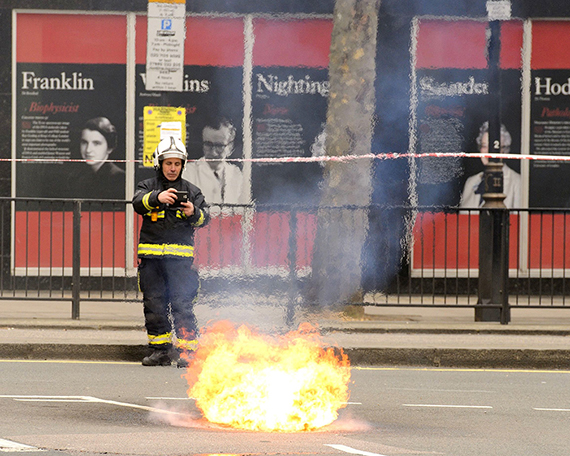 Helen Cairns and George Mortimer consider the insurance issues raised by the recent Holborn fire
Helen Cairns and George Mortimer consider the insurance issues raised by the recent Holborn fire
Last month an underground fire broke out in Holborn, central London. Offices, shops, restaurants and theatres had to close and more than 2,000 workers and local residents were evacuated as the emergency services had no choice but to disconnect local power and gas supplies and close roads and pavements in the area.
It took 36 hours to put the fire out, but it took longer to restore key services to many businesses. The incident showed the extent (and, for occupiers, the limitations) of the insurance traditionally effected by landlords and the need for tenants to create an insurance package to cover disruptions to their businesses.
The time-honoured solution
Most commercial leases oblige the landlord (at the tenant’s expense) to effect buildings insurance on an “all risks” basis and then go on to provide for exclusions and limitations. They also provide that the rent will be suspended (wholly or partly) if the premises are damaged by an insured risk.
The Model Commercial Lease initiative (www.modelcommerciallease.co.uk) was commissioned by the British Property Federation with the aim of providing a “fair starting point” for landlords and tenants. Its suite of leases eloquently follow the traditional line, but also go on to address uninsured risks. Some occupiers see the issue of uninsured risks as being one of damage by terrorism, but it is wider than that and includes risks that may become impossible to insure economically or effectively in the future.
Exactly how uninsured risks are dealt with depends on the property and the parties. Sometimes, the rent is suspended (and perhaps the service charge as well) even though there is no insurer to maintain the landlord’s income flow. In the case of a longer lease or a lease of key premises, the tenant may be obliged to continue to pay the rent for a fixed period to allow the landlord to consider whether the uninsured damage is capable of being reinstated.
Business interruption
Insurance provisions in leases, though, are about insuring the landlord’s interest in the building or the fabric of the building and the rental payments it generates. Such provisions would not have helped the displaced businesses in Holborn as, thanks to the efforts of the emergency services, their buildings were not damaged. However, those businesses incurred expenses including lost revenue, fixing costs relating to their buildings (the rent suspension provisions in their leases were not triggered), temporary relocation of staff, establishing alternative working arrangements, and maybe obtaining and operating an uninterrupted power supply system.
After a major incident, business interruption (“BI”) insurance can make the difference between a tenant’s business failing and it being able to continue trading. However, the traditional BI insurance, which covers a limited period of lost turnover when there has been physical damage at the insured’s own premises, may not reflect the needs of modern businesses.
UK manufacturers that assemble products from imported components, or service sector businesses that outsource critical functions to call centres, can be exposed to BI across long supply chains. As in Holborn, a business’s trade can be affected otherwise than by damage to its own property.
Insurers have developed a wide range of BI products to address these needs. But they have also been careful, where they can, to limit their exposure to risks it may be difficult for them to manage. This makes BI insurance a complex area, where an off-the-peg policy may not be the best solution in any particular case.
This complexity can result in apparently unfair claims outcomes. To give one dramatic example, after Hurricane Katrina, the “trends” clause in the insurance for a New Orleans hotel (which is intended to adjust a claim to reflect wider market trends that would have affected the insured’s trade) was interpreted so the BI loss was effectively zero, as the hotel would not have been able to trade in any event as the rest of the city had been destroyed.
Occupiers running complex businesses should seek advice from a specialist broker.
Business interruption Insurance – some issues to consider
What sort of cover is needed?
Does the insured only need to consider its own premises, or cover for its suppliers and service providers? Does the insured want “denial of access” cover that would be triggered by damage to neighbours’ premises or closure by emergency services? A retail tenant might seek “loss of attraction” cover if its own turnover would fall if a nearby anchor tenant had to close. A tenant that is still fitting out might need “delayed start-up” cover.
How will indemnity be calculated?
By reference to turnover, or some other measure? Some businesses are volatile, so a trading floor might agree an average earning per day profit figure with insurers. BI insurance often includes “increased cost of working” to cover additional expenditure for the purpose of reducing the loss of turnover, but a tenant might also want “additional increased cost of working” to cover further expenditure that might not directly impact turnover but will assist the re-assumption or maintenance of business and help preserve goodwill.
Should the indemnity be subject to a “trends” clause?
This could work against an insured, as it did in the Katrina case.
What is the appropriate indemnity period?
Insurers might provide cover for up to 12, 24 or 36 months’ disruption, and may insist on a franchise period – time that must elapse after an incident before cover kicks in. The tenant needs to consider how long it might be before it could expect to be trading as normal following an incident. That could be lot longer for a manufacturer than for a professional services company whose employees could operate from any premises.
Helen Cairns is an associate in the real estate group and George Mortimer is a legal director in the insurance group at DLA Piper UK LLP







